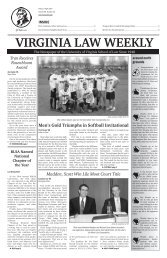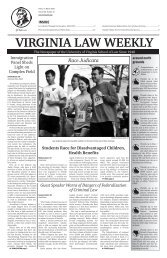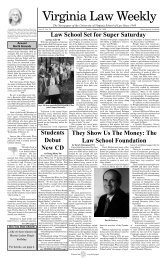VIRGINIA LAW WEEKLY
VIRGINIA LAW WEEKLY
VIRGINIA LAW WEEKLY
- No tags were found...
You also want an ePaper? Increase the reach of your titles
YUMPU automatically turns print PDFs into web optimized ePapers that Google loves.
Friday, 13 February 2009<strong>VIRGINIA</strong> <strong>LAW</strong> <strong>WEEKLY</strong> Reviews 5The Wines of Tuscany: Grape by GrapeRyan Dougherty ’09Reviews EditorTuscany is synonymous with gourmetfood and wine. Use the adjective“Tuscan” to describe spices, saladdressing, or a restaurant and instantlyit is more “sophisticated” and, usually,more expensive. There are severalgood reasons why Tuscany evokessuch images in consumers’ minds.Not only is the region beautiful, butit also has an unparalleled traditionof great art, food, and wine. It is not,however, simply a Disney World forthe senses. Each of these traditionsis deeply embedded in Tuscany’s historyand traditions. It might seemstrange to discuss wine in the samesentence as Michelangelo’s David, butboth reflect aspects of Tuscany thatwill allow the careful and observantindividual to learn much more aboutthis region and its culture than couldever be discovered by reading UnderThe Tuscan Sun or eating at the OliveGarden.So, what’s so special about thewine from this part of the world?Before we get to that, however,there is an important practical differencebetween shopping for Americanand European wines: Most Europeanwines will not tell you the type ofgrape that is in the bottle. Instead,the label will simply tell you wherethe wine is from and you must knowwhat grape is grown in that area. Europeanwinemakers are starting toinclude more information on their labels,but for the most part the burdenis on the consumer. This review willbreak Tuscany down by the grapesthat are grown in and around the differentcities that define the region’swine landscape.SangioveseThis is the defining grape of Tuscany.It is the predominant grape inthe region’s most famous wine, Chianti,as well as its most expensive,Brunello di Montalcino.At one time the Chianti that wasimported to America was pretty awfuland served to unsuspecting patronsat not-very-good Italian restaurants.Things are quite different these daysas there are some delicious Chiantisout there.A large region located around thesouth of Florence, Chianti is dividedinto several smaller regions. The mostprestigious of these is called ChiantiClassico. In general, the most expensivewines from the regions are ChiantiClassico Riservas, which will usuallyinclude the best grapes from thatparticular vintage. Although mostChiantis are made to be consumedearly in their lives, these Riservascan be aged in good vintages. MostRiservas are not prohibitively expensive,however, because Chiantis arefundamentally food wines. They aretypically medium-bodied with cherryand blackberry flavors and goodacidity. As you might expect, they willpair well with most of your favoriteItalian pastas and pizzas.The most expensive examples ofthe Sangiovese grape grown in Tuscanyare produced near the smalltown of Montalcino, which is southof Siena. The winemakers here use amore robust clone of the Sangiovesegrape called Sangiovese Grosso. Thisvarietal grape helps produce Brunellosthat are much richer and fullerbodiedthan Chiantis. These winescan be aged for a long period of time.There are three classes of winefrom Montalcino. The least expensiveis called Rosso di Montalcino. Agedfor a short period of time and oftenpriced between $25 and $35, thesewines are great for a special Italianmeal. The middle group is calledBrunello di Montalcino; these winescan range from $50 to more than$100. They are aged for five yearsbefore release and are often some ofthe best wines produced in Italy forany particular year. Finally, the mostexpensive are Brunello di MontalcinoRiservas. These wines are aged forsix years, use the best grapes fromthe best vines, are produced in smallquantities, and are usually more than$100.At their best, Brunellos will haverich cherry and spice flavors on thepalate preceded by beautiful floralaromas. Too rich for most tomatobasedpasta sauces, these will workbest with beef—which is a staple foodof the region. For example, shouldyou ever splurge on good BisteccaFiorentina (Steak Florentine), lookfor a wine from Montalcino to serveas a complement.Finally, another very good, butunderappreciated, version of Sangioveseis grown around the small townof Montepulciano in eastern Tuscany.Called Vino Nobile di Montepulciano,these bottles range from $20 to $35.Some producers also make reserves,which, of course, are much more expensive.In general, these wines splitthe difference between Chianti andMontalcino in terms of richness and,therefore, can be quite versatile.Recommended WinesChianti: Castello di Poppiano, $13;Felsina Chianti Classico, $25Brunello di Montalcino: CastelloBanfi Rosso di Montalcino, $25; CiacciPiccolomini Brunello, $60Vino Nobile di Monetepulciano:Avignonesi, $30French Varietals (Cabernet Sauvignonand Merlot)In recent years, Italian winemakershave started to grow the internationallypopular Cabernet Sauvignonand Merlot grapes with great success.This trend started with experimentsin blending Cabernet with Tuscany’sSangiovese. Because they did not adhereto strict Italian agricultural rulesgoverning which grapes could go intowhich wines, these blends took on anew moniker: “Super Tuscans.”While Cabernet and Merlot are allaround Tuscany, the best examplesof these newer grapes are found inthe small coastal region of Bolgheri.Today this region produces some ofTuscany’s rarest and most expensivewines. The best are produced byTenuta dell’Ornellaia which makesa Cabernet-based “Ornellaia” anda Merlot-based “Masseto,” each ofwhich retails for over $250.Although these are not nativeItalian varietals, they still fit withinthe general profile of big, bold, andspicy Italian red wines. What someof these wines lack, however, is thegood acidity that many Sangiovesebasedwines possess. This means thatthe wines will be a little less versatileif you’re trying to pair them with pastasor pork, but still great with heartybeef dishes.Recommended WinesSuper Tuscan (with Sangiovese):Campaccio Terrabianca, $30; Tignanello,$85Super Tuscan (no Sangiovese): OrnellaiaLe Serre Nuove, $50; Guadoal Tasso, $90Finally, you’re probably askingwhether any white wine is made inTuscany. It is; it’s just not very popularand not always easy to find. Themost popular and readily available iscalled Vernaccia di San Gimignano.Famously known as Michelangelo’sfavorite wine, it is a pleasant wineand not usually very expensive.However, if you’re looking for goodItalian whites, it’s better to look farthernorth to the Veneto and Piedmont.But, in the end, Tuscany is a redwine kind of place, which makessense given that its cuisine is dominatedby richly flavored pasta, game,and beef dishes. Moreover, most ofthese wines have developed aroundspecific towns that have their ownidentities and climates which havebeen imparted to the wines themselves.This, in fact, goes for the majorityof European wines. So, staytuned, because next week we’ll lookat the French region of Burgundy,one of the most complex and uniquewine regions in the world.London: A Micheneresque (Fact-Intensive, Boring) Shopping ReviewCraig Smith ’09Editor-in-ChiefAfter nearly two years, it was finallytime to take a honeymoon.My wife had been pining to returnto London, which was convenientsince (a) I had never been, and (b)I wanted to do some shopping. Thisis a report of my experiences for anyoneelse who has dreams of takingadvantage of the faltering pound.Certainly there are many peoplewho have more experience shoppingin London than I do. They couldtell you about plenty of great shopstucked away in this neighborhoodand on that street. I just didn’t knowthe city that well and write this as agreenhorn’s guide to a shopping experienceon par only with Manhattan.First thing to deal with are locations.There are four principal areasthat somewhat border half of HydePark: Oxford Street, Bond Street,Knightsbridge, and Jermyn Street/Savile Row. A fifth neighborhood,Covent Garden, is basically TimesSquare East and didn’t warrant avisit.Oxford Street is home to whatBrits call “High Street” shops andwhat we call mass merchandisers.Picture Disney, Foot Locker, and Gapmixed together with their Englishequivalents. By far the heaviest foottraffic is on this thoroughfare.Bond Street (divided into old andnew) dead-ends in the middle ofOxford Street’s commercial street.It’s home to pricey, internationalboutiques, some of superlative qualityand some just trading on theirnames. Mrs. Smith and I came homewith nothing from this block, as wecouldn’t get past the hordes of Russianbillionaires or the price tags.East and south of the other endof Bond Street lie the menswearshops of Jermyn Street (shirts), SavileRow (tailored clothing), andsome connecting avenues. No longerexclusively the province of bespokeclothiers of our parents’ andgrandparents’ era, the traditionalshops are now joined by boutiquesselling high quality goods at fairlyhigh prices, more middle-marketfirms with correspondingly lowerprices, and, oddly, Abercrombie &Fitch. Though rents (and prices)continue to increase, these shopsprobably offer the best overallprice-to-quality ratio of these fourneighborhoods.Finally, Knightsbridge lies westand slightly south of Bond Street.This is the most expensive part ofLondon. It’s said that only sovereignnations building embassies can affordthe real estate there these days.Think of this as Bond Street Southwest,but with some popular departmentstores and museums—mostnotably the Victoria & Albert—addedinto the mix. Incidentally, withso many beautiful homes and minimansions,this is a great neighborhoodfor an aimless stroll.With your geography now set,you should next consider the type ofshopping experience you seek.Worthy of first mention is the Londondepartment store. These have tobe seen in person to be appreciated.They’re relics of an earlier shoppingtime, when everything was underone roof. Beyond the football fieldsizedapparel departments, you’llfind groceries, greeting cards, multiplecafes, electronics large and small,and travel agents to help plan yournext getaway. Most famous are Selfridges(Oxford Street) and Harrods(Knightsbridge). Both occupy fivefloors of full city blocks; Selfridgeseven operates a hotel on-site.You’ll want to visit these retail omnipresencesfor the amusement andto help plan your other shopping.These stores are laid out almost entirelyin mini-boutiques, called “concessions.”It’s not just the Men’s Suitsor Misses’ Fashion. It’s Men’s Suitssubdivided by fifteen brands, witheach zone featuring distinct styling,layouts and merchandise mixes. Ifyou can stomach the crowds—andthey are brutal—these shops offerefficient tours of what London’sother shopping neighborhoods haveto offer.Should you like what you see at aparticular concession, plan to visitthe actual stores, where the hasslefactor is much lower. Of those shops,you should consider the British highstreet brands if their styles appeal toyou. American-based labels, whetherexpensive or moderately priced,should be skipped until returninghome. Prices on those goods weregenerally higher than in the States.Should the smaller British-basedmerchants of Jermyn-Savile type fityour bill, try to do some homeworkahead of time. A typical shop ismuch smaller than in the rest of thecity. They border on claustrophobicif you’re “just browsing.” I tried tostay out of shops where I didn’t havea particular item in mind.Your final question is what to purchase.There’s really everything forall tastes, from low-cost cutting edgeskirts at Topman (Britain’s H&M) tolacquered mahogany chests for yoursterling silver flatware (50% off at£20,000, silver not included). Butif you’re into patterned men’s dressshirts with spread collars and classicmen’s shoes, this is the city for yourexchanged dollars. London offers adeeper selection of these items at agreater variety of price points thandoes New York or any other Americanshopping destination. In classicstyles, shoes ranged from $150 toover $1,000 and shirts from $30 to$300 and higher. Generally, you getwhat you pay for quality-wise if youstick to British-based merchants.Taxes should also be a final consideration.You can get part of theEU-imposed taxes refunded whenyou head home; larger stores tend tokeep sizeable “administrative fees.”Additionally, look into the importduties imposed upon your returnto the States. You can bring back acertain dollar amount tax-free andmust pay duties on goods above thatthreshold. Believe it or not, this wasa concern for me.Title SummaryProCon GradeThe FutureAmazon Kindle 2;February 24, 2009;$359The Kindle 2 is Amazon’s improvedversion of its popular Kindle readingdevice. Equipped with 3G wireless service,the Kindle 2 can download books,newspapers, and magazines directly.The higher resolution screen is alsodesigned to be eye-friendly to lure oureyes away from the printed word tothe digital world (unlike the computerscreens we’ll be staring at in our lawfirm offices).Amazon is seizing on the onething that an iPhone can’t do:provide a screen big enoughfor reading large amounts oftext. Apparently they are doingit well too, because the Kindlesold out during the holidaysand has continued to be popular.The second-generation versionhas a number of enhancementsincluding better batterylife and a thinner profile.I love books. I always have,and even though I love electronicgadgets I am nostalgicand too attached to a bound,published book. Also, you’dhave to read A LOT of booksto justify this $359 price tag,considering you can readmost newspapers for free onthat iPhone or your computerat work and most books costabout $10.B+











